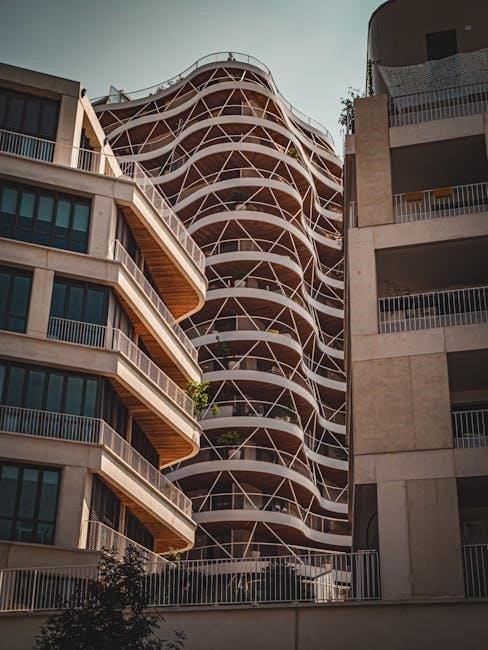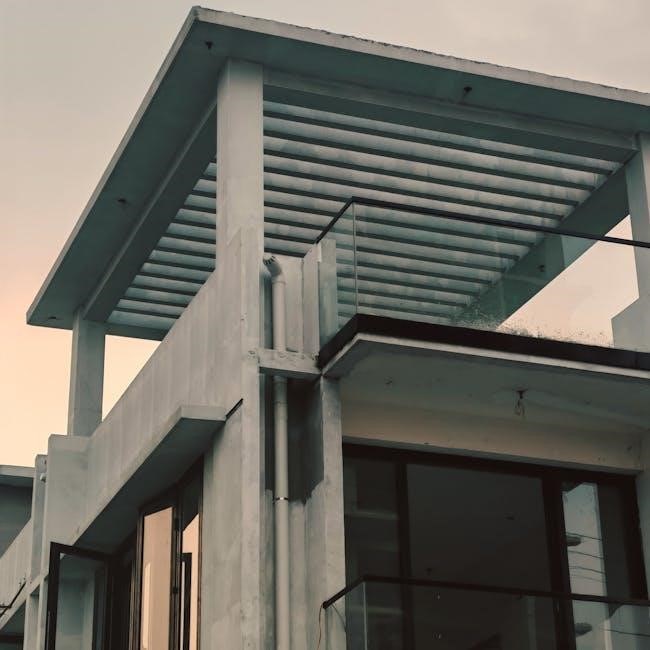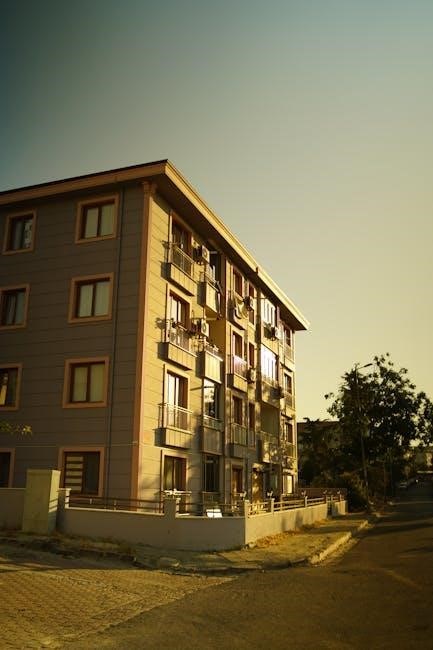Welcome to the Prescriptive Residential Deck Construction Guide. This comprehensive resource provides essential design details, safety guidelines, and construction tips to build durable and safe decks compliant with local building codes.
1.1 Overview of the Guide
This guide provides a comprehensive approach to residential deck construction, offering clear prescriptive methods for designing and building safe, durable decks. It covers essential aspects such as materials, structural components, and compliance with local building codes. The guide is tailored for homeowners, builders, and inspectors, ensuring decks meet safety standards while addressing common construction challenges. It includes detailed diagrams, tables, and checklists to simplify the process. By following this guide, you can create a structurally sound deck that enhances your home’s functionality and aesthetic appeal while adhering to regulatory requirements.
1.2 Importance of Following Prescriptive Guidelines
Following prescriptive guidelines ensures your deck is structurally sound, safe, and compliant with local building codes. These guidelines address critical factors like load capacity, material specifications, and construction techniques, minimizing risks of collapse or injury. Adhering to them helps avoid costly repairs and legal issues. Properly designed decks enhance home value and provide peace of mind for homeowners. By following these guidelines, you ensure a durable and safe outdoor space that meets both regulatory and safety standards, while also protecting your investment in the deck’s construction.

Planning and Designing Your Deck
Plan your deck by determining size, layout, and materials, ensuring compliance with local codes. Consider design elements like stairs, railings, and ledger board placement for functionality and safety.
2.1 Determining Deck Size and Layout
When determining deck size, consider space availability, intended use, and budget. Measure your yard to ensure proper fit. Layout should include ledger board placement, post locations, and traffic flow. Use graph paper to sketch the design, ensuring compliance with local building codes. Consider future additions like stairs or railings. Proper planning prevents costly mistakes. Ensure all measurements are accurate and aligned with structural requirements for safety and stability. A well-designed layout enhances functionality and aesthetic appeal. Refer to the Prescriptive Residential Deck Construction Guide for detailed guidelines and examples.
2.2 Choosing the Right Materials
Selecting the right materials is crucial for durability and safety. Pressure-treated lumber is ideal for structural components due to its rot resistance. Composite decking offers low maintenance and longevity, while natural woods like redwood or cedar provide aesthetic appeal. Always ensure materials meet local building codes and are rated for outdoor use. Consider factors like budget, climate, and desired appearance. Proper fasteners and finishes are essential to protect the deck from weathering. Refer to the guide for recommended materials and their specifications to ensure a sturdy and long-lasting structure. Choose wisely to balance cost, performance, and visual appeal.
2.3 Understanding Local Building Codes and Regulations
Before starting your deck project, consult local building codes and regulations to ensure compliance. These codes vary by location and outline specific requirements for deck construction, including structural integrity, materials, and safety features. Familiarize yourself with the International Residential Code (IRC) provisions related to decks. Obtain necessary permits and inspections to avoid fines or legal issues. Compliance ensures your deck is safe and meets community standards. Always verify setback requirements, material specifications, and load-bearing capacities. Adhering to local regulations guarantees a structurally sound and legally approved deck, avoiding potential hazards and ensuring long-term reliability.

Foundation and Footings
A sturdy foundation is critical for deck stability. Proper footings distribute weight evenly, preventing shifting and ensuring structural integrity. They must meet local building codes for safety and durability.
3.1 Types of Footings for Deck Construction
Deck footings are essential for transferring the weight of the structure to the ground. Common types include spread footings, which distribute load over a wide area, and caisson footings, which extend deeper into the soil for added stability. Piers are another option, often used for elevated decks, providing a solid base for posts. Each type must be designed according to soil conditions and local building codes to ensure safety and prevent structural failure. Proper installation is critical to maintain deck integrity and withstand environmental stresses like frost heave or settlement.
3.2 Spacing and Depth Requirements
Footing spacing and depth are crucial for deck stability. Typically, footings should be spaced no more than 8 feet apart, depending on beam size and load capacity. Depth requirements vary by location, with frost-protected footings needing to extend below the frost line to prevent shifting. In areas with unstable soil, deeper footings may be necessary. Always consult local building codes for specific requirements. Properly spaced and deepened footings ensure the deck remains level and secure, preventing structural issues over time.
3.4 Inspections and Approvals
Inspections and approvals are critical steps in deck construction. A qualified inspector will verify that the foundation, footings, beams, and posts meet local building codes and the guide’s specifications. Ensure all components are accessible for evaluation. Obtain necessary approvals before proceeding to the next construction phase. Regular inspections help identify potential issues early, ensuring a safe and durable deck. Compliance with these steps guarantees adherence to safety standards and avoids costly rework. Always schedule inspections in advance to maintain your project timeline and meet regulatory requirements effectively.
Beams and Posts
Beams and posts are critical structural elements, ensuring deck stability and weight distribution. Proper sizing, material selection, and installation are essential for safety and code compliance.
4.1 Sizing and Spacing of Beams
Beams are essential for supporting deck loads and ensuring structural integrity. Their sizing and spacing must align with local building codes and load-bearing requirements. Typically, beams are spaced 16 or 24 inches on-center, depending on joist span and decking material. The International Residential Code (IRC) provides specific guidelines for beam sizing based on lumber type and load capacity. Proper beam installation ensures even weight distribution, preventing sagging or failure. Always refer to the Prescriptive Residential Deck Construction Guide or local building codes for precise beam sizing and spacing requirements to guarantee safety and compliance. Proper planning prevents structural issues;
4.2 Post Height and Anchorage Requirements
Deck posts must be sized and anchored properly to ensure stability and safety. Post height is determined by deck elevation and local building codes, typically requiring a minimum of 12 inches embedment into concrete footings. Posts should be anchored with approved hardware, such as post-base connectors, to resist uplift and lateral forces. The IRC specifies minimum embedment depths and concrete strength for footings. Proper anchorage prevents deck collapse and ensures structural integrity. Always verify local regulations for specific post height and anchorage requirements to meet safety standards and pass inspections. Secure installation is critical for long-term durability and reliability. Plan carefully to avoid costly corrections later.

Joists and Framing
Joists and framing form the structural backbone of your deck. Proper joist span, size, and spacing ensure safety and durability. Correct connections are vital for structural integrity.
5.1 Joist Span and Size Requirements
Joist span and size are critical for ensuring deck safety and structural integrity. The Prescriptive Residential Deck Construction Guide provides detailed tables to determine the maximum allowable span for various joist sizes based on lumber type and spacing. Proper sizing ensures the deck can support intended loads without sagging or failure. Always consult local building codes for specific requirements and ensure materials meet standards. Proper installation and alignment of joists are essential to maintain structural integrity and safety.
5.2 Framing Layout and Connections
A well-planned framing layout ensures structural stability and safety. Beams, posts, and joists must be properly aligned and connected to distribute weight evenly. Ledger boards should be securely attached to the house using approved fasteners, while beam-to-post connections require sturdy hardware. Joists should be spaced consistently and attached to beams with joist hangers or appropriate connectors. Proper spacing and alignment prevent warping and ensure even load distribution. Always use corrosion-resistant fasteners and follow manufacturer instructions for connections. Regular inspections of framing connections are crucial for long-term safety and durability.

Decking Boards
Decking boards are available in various materials, including pressure-treated lumber, composite, and hardwood. Proper installation involves maintaining uniform spacing between boards and using appropriate fasteners to ensure durability and safety. Correct spacing prevents warping, while secure fasteners enhance structural integrity, ensuring a long-lasting and safe deck surface.
6.1 Types of Decking Materials
Pressure-treated lumber is a cost-effective option, offering durability against rot and insects, making it ideal for structural components. Composite decking combines plastics and wood fibers, providing low-maintenance and weather resistance. Hardwoods like Ipe and Teak are prized for their beauty and longevity but require regular sealing. Softwoods, such as cedar, are naturally resistant to pests and offer a rustic charm, though they are softer than hardwoods. Each material has unique benefits and drawbacks, so choosing the right one depends on budget, desired appearance, and maintenance preferences.
6.2 Installation Patterns and Spacing
Decking boards can be installed in various patterns, such as linear, diagonal, or herringbone, to enhance visual appeal. Proper spacing is essential for drainage and to accommodate material expansion. Typically, a 1/8-inch gap is recommended between boards to prevent warping and moisture issues. For composite decking, follow manufacturer guidelines, as some materials require slightly wider gaps. Ensure screws or nails are driven flush with the surface to avoid tripping hazards. Always pre-drill holes for screws in hardwoods to prevent splitting. Correct installation ensures a durable, safe, and aesthetically pleasing deck surface. Proper spacing also extends the lifespan of the decking material.

Railings and Guardrails
Railings and guardrails ensure safety and must meet specific requirements. Minimum height is typically 36 inches, with balusters spaced no more than 4 inches apart. The system must support a 50-pound load per square foot. Materials vary, including wood, metal, or composite, and must comply with local building codes.
7.1 Height and Strength Requirements
Railings and guardrails must meet specific height and strength standards to ensure safety. The minimum height for railings is typically 36 inches above the deck surface. Guardrails must be able to withstand a minimum lateral load of 50 pounds per square foot. These requirements ensure the structural integrity of the system, preventing collapse under normal use. Testing and inspection may be required to verify compliance. Materials should be durable and weather-resistant, such as wood, metal, or composite decking materials. Proper installation is critical to meet these standards and ensure user safety.
7.2 Baluster Spacing and Design
Balusters, the vertical posts in railings, must be spaced no more than 4 inches apart to prevent accidents, especially involving children. They should be securely attached to the top and bottom rails using durable fasteners. Materials like wood, metal, or composite are common choices, ensuring both strength and aesthetic appeal. The design should align with local building codes and complement the deck’s overall style. Proper spacing and secure installation are critical to ensure safety and structural integrity. Regular inspections are recommended to maintain compliance and prevent potential hazards.

Stairs and Landings
Stairs and landings are critical for safe deck access. Proper construction ensures they can handle weight and usage, with designs meeting local building codes and safety standards.
8.1 Stringer and Tread Requirements
Stringers, the structural elements of stairs, must be sized to support loads safely. Treads should be at least 10 inches deep for comfort and safety. The rise between treads should not exceed 7.75 inches, ensuring ease of use. Both stringers and treads must be constructed from durable, pressure-treated lumber to withstand weather conditions. Proper fastening techniques are essential to prevent movement over time. Always follow local building codes and IRC guidelines for precise measurements and materials to ensure structural integrity and compliance with safety standards. Regular inspections are recommended to maintain stability and performance.
8.2 Landing Size and Guardrail Requirements
Landing platforms between stair flights must be at least 36 inches deep to ensure safe footing. Guardrails are mandatory for landings more than 30 inches above grade, with a minimum height of 36 inches. Railings should be sturdy, using materials like wood or metal, and spaced no more than 4 inches between balusters for safety. Posts must be securely anchored to the deck frame. Always verify local building codes for specific requirements, as they may exceed these standards. Proper installation ensures both safety and compliance, preventing potential hazards and structural issues over time.

Fasteners and Connectors
Fasteners and connectors are critical for deck structural integrity. Use galvanized or stainless steel lag screws, bolts, and joist hangers to ensure durability and safety. Always follow manufacturer guidelines.
9.1 Types of Fasteners for Deck Construction
Galvanized or stainless steel fasteners are ideal for deck construction due to their resistance to corrosion. Common types include lag screws, bolts, and deck screws. Joist hangers and post anchors are also essential for securing structural components. Ensure all fasteners meet local building codes and are rated for outdoor use. Properly tighten all connections to maintain structural integrity and safety. Always follow manufacturer instructions for installation and torque specifications to prevent loosening over time.
9.2 Proper Use of Joist Hangers and Connectors
Joist hangers are essential for securing joists to beams, ensuring structural stability. Choose hangers sized to fit your joist dimensions and load requirements. Install them flush against the beam, ensuring proper alignment and seating. For connectors, use corrosion-resistant hardware like galvanized or stainless steel. Post-to-beam and joist-to-beam connectors are critical for distributing weight evenly. Tighten all bolts and screws securely to prevent movement. Always follow manufacturer instructions and verify compliance with local building codes. Properly installed connectors and hangers ensure a safe and durable deck structure.

Safety Considerations
Ensure your deck can support intended loads, adhering to weight limits. Regularly inspect for rot or damage. Install guardrails and lighting for safety, complying with local codes.
10.1 Load Capacity and Weight Limits
Deck load capacity is critical for safety. The Prescriptive Residential Deck Construction Guide specifies that decks must support a minimum of 40 pounds per square foot for live loads and 10 pounds per square foot for dead loads. This ensures the structure can handle people, furniture, and additional elements like hot tubs or grills. Exceeding these limits can lead to structural failure. Always verify local building codes, as they may require higher capacities. Proper design and materials selection are essential to meet these standards and ensure your deck remains safe for years to come.
10;2 Electrical and Lighting Safety
Ensuring electrical and lighting safety is crucial for a secure deck environment. Install outdoor-rated lighting and outlets, as they are designed to withstand weather conditions. Keep electrical components at least 12 inches above the deck surface to prevent water exposure. Avoid overloading circuits with too many devices, as this can cause electrical hazards. Always hire a licensed electrician for complex installations. Adhere to local building codes and the National Electric Code (NEC) guidelines. Regularly inspect wiring and lighting fixtures for damage or wear. Proper electrical planning prevents fires and ensures a safe, enjoyable outdoor space for years to come.

Maintenance and Inspection
Regular cleaning and inspection are essential to extend the life of your deck. Check for rot, damage, or loose hardware, and address issues promptly to ensure safety and durability.
11.1 Regular Maintenance Tasks
Performing routine maintenance ensures your deck remains safe and visually appealing. Start by clearing debris from between boards to prevent moisture buildup. Sand and seal the decking annually to protect against weathering. Inspect fasteners, tightening any loose screws or bolts. Check railings for stability and ensure all connectors are secure. Additionally, power wash the deck every few years to remove dirt and mildew. Address any signs of rot or damage promptly to prevent structural issues. Regular maintenance not only extends the lifespan of your deck but also enhances its aesthetic appeal and safety for years to come.
11.2 Inspection Checklist
Regular inspections are crucial for identifying potential issues before they become safety hazards. Begin by examining the deck’s foundation, ensuring footings are stable and posts are securely anchored. Check joists for signs of rot or damage, and verify that all fasteners are tight and corrosion-free. Inspect railings for proper height and baluster spacing, ensuring they meet local building codes. Look for any sagging or unevenness in the deck boards and verify that ledger boards are properly attached to the house. Finally, ensure stairs have secure stringers and treads, and all guardrails are in place. This checklist helps maintain safety and structural integrity.
This guide provides a comprehensive framework for building safe, durable decks. By following its principles, you ensure compliance with codes and create a lasting outdoor space.
12.1 Final Tips for a Successful Deck Build
Building a deck requires careful planning and adherence to safety standards. Start by ensuring all materials meet local building codes and are suitable for outdoor use. Regularly inspect your deck for signs of wear or damage, addressing issues promptly to prevent structural problems. Consider consulting professionals for complex designs or large-scale projects. Always follow manufacturer instructions for tools and materials to ensure durability. Finally, maintain your deck with seasonal cleaning and protective treatments to extend its lifespan and keep it safe for years to come. Proper planning and maintenance are key to a successful deck build.
12.2 Resources for Further Reading
For further guidance on deck construction, consult the AWC Prescriptive Residential Deck Construction Guide, which offers detailed design and safety standards. Additionally, review the International Residential Code (IRC) for local building requirements. Websites like Fine Homebuilding and DeckMagazine provide practical tips and case studies. Local hardware stores and building departments often offer workshops or pamphlets on deck safety and materials. These resources ensure a well-informed and compliant deck-building process, helping you create a safe and durable outdoor space for years of enjoyment.

No Responses